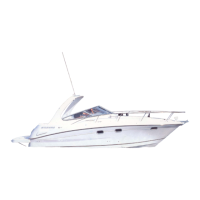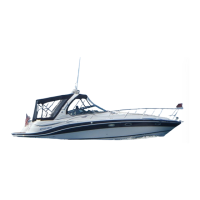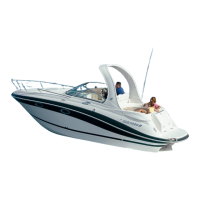Do you have a question about the Four winns 348 Vista and is the answer not in the manual?
Key safety information and warnings for new boat owners.
General overview of boat operation and pre-checks.
Understanding boat systems and their operation is essential.
Requirements for safety equipment and its importance.
Responsibilities for passenger safety and behavior aboard.
Essential marine traffic laws for safe boating operation.
Awareness of weather conditions and safety during storms.
Prohibition and dangers of operating a boat under the influence.
Checklist of essential items to inspect before leaving the dock.
Step-by-step guide for starting and operating the engine.
Procedures and precautions for handling grounded or disabled vessels.
Importance of boating courses and recommended literature.
Requirements for boat registration with state agencies.
Procedures for reporting boating accidents and legal requirements.
Regulations prohibiting oil discharge into waterways.
Regulations on discarding refuse overboard to protect marine environments.
Regulations concerning waste disposal for larger vessels.
Owner's responsibility for ensuring all required safety equipment is aboard.
Hazards of carbon monoxide from exhaust fumes and prevention.
Guidelines for safe operation, passenger safety, and responsible boating.
Safety precautions for popular water sports like skiing and wakeboarding.
Rules of seamanship, navigational aids, and boating education resources.
Understanding aids to navigation for safe travel on water.
Suggested literature for further boating knowledge.
Contact information for boating organizations and resources.
Forms for logging trips, fuel, and service for boat maintenance.
Chart detailing whistle signals, storm warnings, and buoy descriptions.
Details of the Winning Edge™ Owner Protection Plan and warranty coverage.
Specific warranty coverage for the boat's deck and hull structure.
Process and importance of registering the warranty card for validation.
Procedures for transferring the boat's warranty coverage to a new owner.
Encouragement for pre-owned boat owners to register their ownership.
Responsibility of boat owners to acquire proper insurance protection.
Recording serial numbers of boat components for service and warranty.
Dealer's responsibility for thorough boat inspection before delivery.
Information on obtaining Four Winns parts and support.
Key responsibilities of the boat owner for safe operation and maintenance.
Compliance with USCG and ABYC standards for boat construction.
Information on Four Winns branded sports clothing and accessories.
Safety precautions for engine servicing and manufacturer requirements.
Hazards of carbon monoxide in exhaust fumes and passenger safety.
Types of engine and drive systems (stern drive, inboard V-drive).
Inspection and maintenance of underwater components like shaft logs and struts.
Understanding propeller terminology like diameter and pitch.
Operation of raw water and fresh water cooling systems.
Adjusting boat attitude for optimal performance using trim and tilt.
Using trim tabs to control hull attitude and improve performance.
Overview of helm station gauges and their functions for engine monitoring.
Components of control systems, including electronic binnacle controls.
General procedures for operating engine controls and synchronization.
Function of the neutral safety switch and its role in engine starting.
Basic maintenance recommendations for the control unit.
Types of steering systems (tilt, rotary, power, hydraulic).
Factors affecting steering effort and load on the system.
Information on inboard rudders, their alignment, and maintenance.
Function and operation of the rudder angle indicator.
How propeller torque affects steering and boat handling.
Periodic inspection and maintenance of steering system components.
Overview of the boat's electrical systems, including battery and AC power.
Installation and operation of the triple battery system.
Functionality and charging of batteries from dockside power or generator.
Monitoring battery condition and alternator performance with voltmeters.
Descriptions and protection for various 12-volt helm and interior equipment.
Steps to properly shut down the electrical system when leaving the boat.
Information on the AC electrical system and its components.
Procedures for connecting and disconnecting shore power safely.
Operation and maintenance of the standard generator for AC power.
Routine maintenance for batteries, wiring, and electrical connections.
Understanding and preventing corrosion caused by electrical systems.
Design and inspection of gasoline fuel systems according to industry standards.
Cautions regarding the use of alcohol-blended gasoline and its effects.
Safe procedures and recommendations for fueling the boat, including precautions against static sparks.
Overview of the fresh water supply system and its components.
Priming, operation, and maintenance of the pressurized water system.
Optional grey water system description and overboard discharge regulations.
Connecting to shoreside water supply for a constant fresh water source.
Operation and use of the standard transom shower.
Operation of the VacuFlush® sanitation system and head with overboard discharge.
Maintenance of water and waste systems, including winterizing.
Importance of engine compartment ventilation for safety and preventing CO buildup.
Ensuring proper cabin ventilation to prevent carbon monoxide accumulation.
Function and maintenance of transom drains, bilge pumps, and sumps.
Operation and safety of galley appliances like stoves and microwaves.
Features and components of the available refreshment center.
Operation of the stereo system and TV/DVD player.
Operation, maintenance, and winterizing of the air conditioning unit.
Installation and maintenance of deck hardware like rails and cleats.
Operation and safety of the transom door for cockpit access.
Operation and care of the companionway door and its acrylic components.
Cleaning and care of windshields and cabin windows (plexiglass).
Features and maintenance of foredeck hatches, including screens and blinds.
Features and safe use of the integrated swim platform and boarding ladder.
Overview of storage compartments provided throughout the cockpit area.
Storage solutions provided in the transom locker for convenience.
Functional base for anchoring and safety precautions for the bow platform.
Operation of the electric windlass for anchor retrieval.
Design and purpose of the radar arch for equipment installation.
Operation of the remote-controlled spotlight.
Operation of the engine hatch with electric lift or screw jack.
Details of interior seating arrangements, including cabin table and berths.
Features and adjustability of the helm seat and stern seating.
Cleaning and maintenance of interior fabric and vinyl upholstery.
Procedures for cleaning and maintaining exterior vinyl and carpet.
Availability of replacement upholstery cushions and parts.
Information on weather covers for cockpit protection and material care.
Guidelines for safely installing and removing canvas covers.
Precautions for trailering boats with weather covers installed.
Installation and use of the standard bimini top for forward cockpit shade.
Installation and use of the standard camper canvas for aft cockpit enclosure.
Optional cockpit cover for short-term storage and safety during use.
Safe use of weather covers and awareness of carbon monoxide hazards.
Protecting the boat during winter dry dock storage with covers.
Maintenance recommendations for weather covers to ensure longevity.
Principles of hull design, materials, and construction techniques.
Quality of fiberglass components and construction methods used.
Proper procedures for installing equipment onto fiberglass components.
General maintenance for fiberglass to preserve beauty and finish.
Procedures for repairing common fiberglass damages like scratches and gouges.
Application and reapplication of antifouling paint for hull protection.
Importance of proper hull support when the boat is out of water.
Cleaning and care instructions for high-pressure laminate interior components.
Cleaning and care for cherry wood trim and finishes.
Properties and use of Starboard plastic in boat construction.
Cleaning and maintenance for laminated fiberglass components.
Cleaning and care for vinyl-covered MDF components in the cockpit.
Cleaning and care for optional woodgrain trim enhancements.
Cleaning and care for fiberglass countertops with solid surface inlays.
Properties and care of solid surface materials used in countertops.
Cleaning and care instructions for acrylic plastic (plexiglass) components.
Care and maintenance of the optional Flexiteek cockpit and swim platform.
Procedures for preparing the boat for winter storage, including systems and components.
Procedures for flushing engines to remove salt and debris before winter.
Comprehensive schedule for routine maintenance tasks based on time or usage.
A thorough checklist to ensure the boat is ready for launch and cruising.
Safe procedures and recommendations for fueling the boat.
Guidelines for safely loading passengers and distributing weight.
Step-by-step instructions for pre-start checks and engine starting.
Techniques for leaving the dock, stopping, and general boat handling.
Procedures for bringing the boat onto plane and achieving cruising speed.
Adjusting trim tabs and drive trim for optimal boat performance and handling.
Proper use and function of navigation lights for visibility and safety at night.
Awareness and response to hazardous conditions like storms and fog.
Procedures for handling emergencies such as flooding, capsizing, and fire.
Procedures for docking and mooring the boat safely.
Diagrams and parts lists for various instrument panel configurations.
Wiring schematics for helm and deck switch panels.
Wiring diagrams for various boat systems and components.
Wiring schematic for the windlass relay and foot pedal.
Wiring schematics for water tank and sensor systems.
Key safety information and warnings for new boat owners.
General overview of boat operation and pre-checks.
Understanding boat systems and their operation is essential.
Requirements for safety equipment and its importance.
Responsibilities for passenger safety and behavior aboard.
Essential marine traffic laws for safe boating operation.
Awareness of weather conditions and safety during storms.
Prohibition and dangers of operating a boat under the influence.
Checklist of essential items to inspect before leaving the dock.
Step-by-step guide for starting and operating the engine.
Procedures and precautions for handling grounded or disabled vessels.
Importance of boating courses and recommended literature.
Requirements for boat registration with state agencies.
Procedures for reporting boating accidents and legal requirements.
Regulations prohibiting oil discharge into waterways.
Regulations on discarding refuse overboard to protect marine environments.
Regulations concerning waste disposal for larger vessels.
Owner's responsibility for ensuring all required safety equipment is aboard.
Hazards of carbon monoxide from exhaust fumes and prevention.
Guidelines for safe operation, passenger safety, and responsible boating.
Safety precautions for popular water sports like skiing and wakeboarding.
Rules of seamanship, navigational aids, and boating education resources.
Understanding aids to navigation for safe travel on water.
Suggested literature for further boating knowledge.
Contact information for boating organizations and resources.
Forms for logging trips, fuel, and service for boat maintenance.
Chart detailing whistle signals, storm warnings, and buoy descriptions.
Details of the Winning Edge™ Owner Protection Plan and warranty coverage.
Specific warranty coverage for the boat's deck and hull structure.
Process and importance of registering the warranty card for validation.
Procedures for transferring the boat's warranty coverage to a new owner.
Encouragement for pre-owned boat owners to register their ownership.
Responsibility of boat owners to acquire proper insurance protection.
Recording serial numbers of boat components for service and warranty.
Dealer's responsibility for thorough boat inspection before delivery.
Information on obtaining Four Winns parts and support.
Key responsibilities of the boat owner for safe operation and maintenance.
Compliance with USCG and ABYC standards for boat construction.
Information on Four Winns branded sports clothing and accessories.
Safety precautions for engine servicing and manufacturer requirements.
Hazards of carbon monoxide in exhaust fumes and passenger safety.
Types of engine and drive systems (stern drive, inboard V-drive).
Inspection and maintenance of underwater components like shaft logs and struts.
Understanding propeller terminology like diameter and pitch.
Operation of raw water and fresh water cooling systems.
Adjusting boat attitude for optimal performance using trim and tilt.
Using trim tabs to control hull attitude and improve performance.
Overview of helm station gauges and their functions for engine monitoring.
Components of control systems, including electronic binnacle controls.
General procedures for operating engine controls and synchronization.
Function of the neutral safety switch and its role in engine starting.
Basic maintenance recommendations for the control unit.
Types of steering systems (tilt, rotary, power, hydraulic).
Factors affecting steering effort and load on the system.
Information on inboard rudders, their alignment, and maintenance.
Function and operation of the rudder angle indicator.
How propeller torque affects steering and boat handling.
Periodic inspection and maintenance of steering system components.
Overview of the boat's electrical systems, including battery and AC power.
Installation and operation of the triple battery system.
Functionality and charging of batteries from dockside power or generator.
Monitoring battery condition and alternator performance with voltmeters.
Descriptions and protection for various 12-volt helm and interior equipment.
Steps to properly shut down the electrical system when leaving the boat.
Information on the AC electrical system and its components.
Procedures for connecting and disconnecting shore power safely.
Operation and maintenance of the standard generator for AC power.
Routine maintenance for batteries, wiring, and electrical connections.
Understanding and preventing corrosion caused by electrical systems.
Design and inspection of gasoline fuel systems according to industry standards.
Cautions regarding the use of alcohol-blended gasoline and its effects.
Safe procedures and recommendations for fueling the boat, including precautions against static sparks.
Overview of the fresh water supply system and its components.
Priming, operation, and maintenance of the pressurized water system.
Optional grey water system description and overboard discharge regulations.
Connecting to shoreside water supply for a constant fresh water source.
Operation and use of the standard transom shower.
Operation of the VacuFlush® sanitation system and head with overboard discharge.
Maintenance of water and waste systems, including winterizing.
Importance of engine compartment ventilation for safety and preventing CO buildup.
Ensuring proper cabin ventilation to prevent carbon monoxide accumulation.
Function and maintenance of transom drains, bilge pumps, and sumps.
Operation and safety of galley appliances like stoves and microwaves.
Features and components of the available refreshment center.
Operation of the stereo system and TV/DVD player.
Operation, maintenance, and winterizing of the air conditioning unit.
Installation and maintenance of deck hardware like rails and cleats.
Operation and safety of the transom door for cockpit access.
Operation and care of the companionway door and its acrylic components.
Cleaning and care of windshields and cabin windows (plexiglass).
Features and maintenance of foredeck hatches, including screens and blinds.
Features and safe use of the integrated swim platform and boarding ladder.
Overview of storage compartments provided throughout the cockpit area.
Storage solutions provided in the transom locker for convenience.
Functional base for anchoring and safety precautions for the bow platform.
Operation of the electric windlass for anchor retrieval.
Design and purpose of the radar arch for equipment installation.
Operation of the remote-controlled spotlight.
Operation of the engine hatch with electric lift or screw jack.
Details of interior seating arrangements, including cabin table and berths.
Features and adjustability of the helm seat and stern seating.
Cleaning and maintenance of interior fabric and vinyl upholstery.
Procedures for cleaning and maintaining exterior vinyl and carpet.
Availability of replacement upholstery cushions and parts.
Information on weather covers for cockpit protection and material care.
Guidelines for safely installing and removing canvas covers.
Precautions for trailering boats with weather covers installed.
Installation and use of the standard bimini top for forward cockpit shade.
Installation and use of the standard camper canvas for aft cockpit enclosure.
Optional cockpit cover for short-term storage and safety during use.
Safe use of weather covers and awareness of carbon monoxide hazards.
Protecting the boat during winter dry dock storage with covers.
Maintenance recommendations for weather covers to ensure longevity.
Principles of hull design, materials, and construction techniques.
Quality of fiberglass components and construction methods used.
Proper procedures for installing equipment onto fiberglass components.
General maintenance for fiberglass to preserve beauty and finish.
Procedures for repairing common fiberglass damages like scratches and gouges.
Application and reapplication of antifouling paint for hull protection.
Importance of proper hull support when the boat is out of water.
Cleaning and care instructions for high-pressure laminate interior components.
Cleaning and care for cherry wood trim and finishes.
Properties and use of Starboard plastic in boat construction.
Cleaning and maintenance for laminated fiberglass components.
Cleaning and care for vinyl-covered MDF components in the cockpit.
Cleaning and care for optional woodgrain trim enhancements.
Cleaning and care for fiberglass countertops with solid surface inlays.
Properties and care of solid surface materials used in countertops.
Cleaning and care instructions for acrylic plastic (plexiglass) components.
Care and maintenance of the optional Flexiteek cockpit and swim platform.
Procedures for preparing the boat for winter storage, including systems and components.
Procedures for flushing engines to remove salt and debris before winter.
Comprehensive schedule for routine maintenance tasks based on time or usage.
A thorough checklist to ensure the boat is ready for launch and cruising.
Safe procedures and recommendations for fueling the boat.
Guidelines for safely loading passengers and distributing weight.
Step-by-step instructions for pre-start checks and engine starting.
Techniques for leaving the dock, stopping, and general boat handling.
Procedures for bringing the boat onto plane and achieving cruising speed.
Adjusting trim tabs and drive trim for optimal boat performance and handling.
Proper use and function of navigation lights for visibility and safety at night.
Awareness and response to hazardous conditions like storms and fog.
Procedures for handling emergencies such as flooding, capsizing, and fire.
Procedures for docking and mooring the boat safely.
Diagrams and parts lists for various instrument panel configurations.
Wiring schematics for helm and deck switch panels.
Wiring diagrams for various boat systems and components.
Wiring schematic for the windlass relay and foot pedal.
Wiring schematics for water tank and sensor systems.
| Brand | Four winns |
|---|---|
| Model | 348 Vista |
| Category | Boat |
| Language | English |











